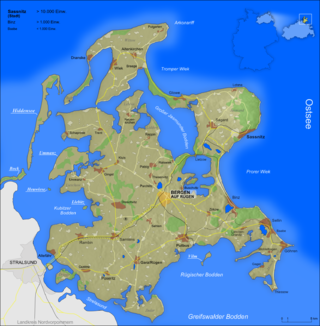
Rügen is Germany's largest island. It is located off the Pomeranian coast in the Baltic Sea and belongs to the state of Mecklenburg-Western Pomerania.

Cape Arkona is a 45-metre (150-foot) high cape on the island of Rügen in Mecklenburg-Vorpommern, Germany. It forms the tip of the Wittow peninsula, just a few kilometres north of the Jasmund National Park. The protected landscape of Cape Arkona, together with the fishing village of Vitt, belongs to the municipality of Putgarten and is one of the most popular tourist destinations on Rügen, receiving about 800,000 visitors annually.
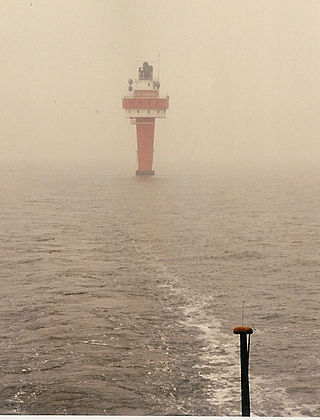
The Alte Weser Lighthouse is located offshore from the estuary mouth of the river Weser in the German Bight, southern North Sea. It was built on sand between 1961 and 1964. The lighthouse took over duties and replaced the historical Roter Sand Lighthouse on 1 September 1964. The latter had been built from 1883 to 1885.

Bergen auf Rügen is the capital of the former district of Rügen in the middle of the island of Rügen in Mecklenburg-Western Pomerania, Germany. Since 1 January 2005, Bergen has moreover been the administrative seat of the Amt of Bergen auf Rügen, which with a population of over 23,000 is Mecklenburg-Vorpommern's most populous Amt.

Garz is a town in the county of Vorpommern-Rügen in the German state of Mecklenburg-Vorpommern. The town is administered by the Amt of Bergen auf Rügen, in the town of the same name.
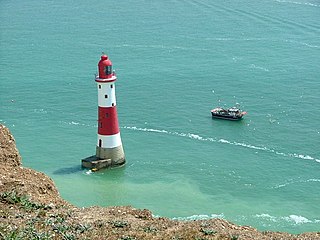
Beachy Head Lighthouse is a lighthouse located in the English Channel below the cliffs of Beachy Head in East Sussex. It is 33 m (108 ft) in height and became operational in October 1902. It was the last traditional-style 'rock tower' to be built by Trinity House.

Altenkirchen is a municipality in the north of the island of Rügen on the Baltic Sea coast of Germany. It is in the Vorpommern-Rügen district, in the federal state of Mecklenburg-Vorpommern.

The Amrum Lighthouse is located in the southern part of the German island of Amrum, approximately 2 kilometres west of the village of Wittdün, yet still adhering to the municipality of Nebel. Its name in German is Seefeuer Amrum. The lighthouse is one of the island's landmarks, being open to the public during the summer season.
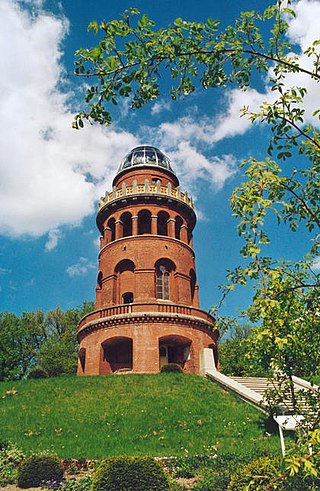
The Rugard, at 91 m above sea level (NN), is the highest elevation in the central region of the German Baltic Sea island of Rügen. This push end moraine was formed in the last ice age and lies on the northeastern perimeter of the town of Bergen auf Rügen. There was probably a castle here from the 9th century to the year 1325 A.D., in which princes of the Slavic Rani tribe resided. These princes ruled Rügen and parts of the adjacent mainland. The Slavic name Rugard dates to that period. The site had an inner and outer ward and covered an area of 2.3 hectares.

Hurst Point Lighthouse is located at Hurst Point in the English county of Hampshire, and guides vessels through the western approaches to the Solent.

Dagebüll Lighthouse is a retired lighthouse in Dagebüll, Nordfriesland, Germany. Until its replacement in 1988 by a direction light on the dock of the Dagebüll ferry port, it served as the lower light of the Dagebüll range of leading lights. The lighthouse is situated in the southern part of the municipality near the depot of the lorry rail to islands of Oland and Langeneß. After an additional storey was added to the tower due to a raise of the sea dike in 1980, the tower is now 12.5 m (41 ft) tall. Its focal height is at 10.3 m (34 ft) above the highest high tide. The lighthouse has a pitched roof, a black and green copper construction.
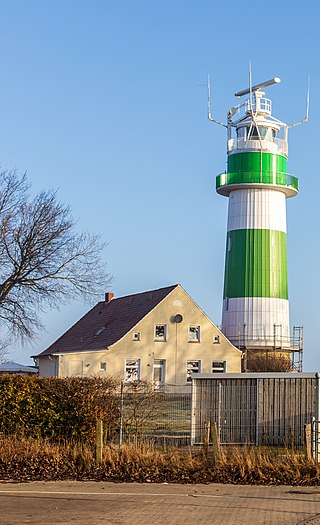
Bülk Lighthouse is on the westernmost headland of the Kieler Förde on the Baltic Sea coast of Schleswig-Holstein, Germany. It is the oldest lighthouse on the Kieler Förde and serves as a guiding light to the entrance into the fjord. A red light sector warns of the Stollergrund shoal. It is a popular attraction for visitors.

Warnemünde Lighthouse is a lighthouse situated on the Unterwarnow, the estuary of the Warnow river, in Warnemünde, a district in the city of Rostock. The lighthouse has a height of 36.9 metres (121 ft) and was put into service in 1898.

Heligoland Lighthouse is located on Germany's only offshore island, Heligoland. Constructed during World War II as an anti-aircraft tower, it was turned into a lighthouse in 1952. It features the strongest light on the German North Sea coast with a range of 28 nautical miles (52 km) so that it can be seen as far as on the East Frisian or the North Frisian islands and Halligen. The lighthouse is operated by the Tönning water and shipping authority.
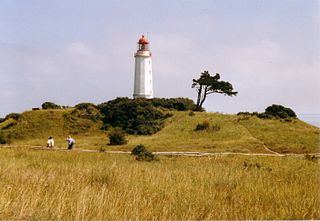
Dornbusch Lighthouse refers to the lighthouse officially designated as Leuchtfeuer Dornbusch/Hiddensee in the north of the German island of Hiddensee in Mecklenburg-Vorpommern on the Baltic Sea coast. Its international serial number is C 2588.

The Jaromarsburg was a cult site for the Slavic tribe of Rani dedicated to the god Svantovit and used from the 9th to the 12th century. It was located on the northeastern tip of the Baltic Sea island of Rügen at Cape Arkona, and was protected on two sides by the cliffed coast and from the land side by a Slavic burgwall.

Whitby Lighthouse is a lighthouse operated by Trinity House. It is on Ling Hill, on the coast to the southeast of Whitby, beyond Saltwick Bay. To distinguish it from the two lighthouses in Whitby itself it is sometimes known as Whitby High lighthouse

Lowestoft Lighthouse is a lighthouse operated by Trinity House located to the north of the centre of Lowestoft in the English county of Suffolk. It stands on the North Sea coast close to Ness Point, the most easterly point in the United Kingdom. It acts as a warning light for shipping passing along the east coast and is the most easterly lighthouse in the UK.
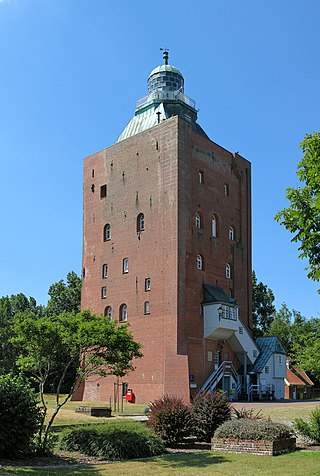
The Great Tower Neuwerk is the most significant building of the Neuwerk island, belonging to Hamburg. Completed in 1310, the structure is one of the oldest worldwide that was used as lighthouse (1814–2014) and still standing. This former beacon, watchtower and lighthouse is also the oldest building in Hamburg and oldest secular building on the German coast.
























